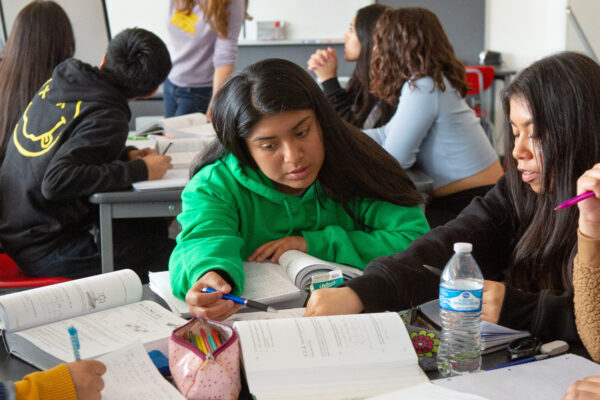What is the best way to teach? Some educators like to deliver clear explanations to students. Others favor discussions or group work. Project-based learning is trendy. But a June 2023 study from England could override all these debates: the most effective use of class time may depend on the subject.
The researchers found that students who spent more time in class solving practice problems on their own and taking quizzes and tests tended to have higher scores in math. It was just the opposite in English class. Teachers who allocated more class time to discussions and group work ended up with higher scorers in that subject.
“There does seem to be a difference between language and math in the best use of time in class,” said Eric Taylor, an economist who studies education at the Harvard Graduate School of Education and one of the study’s authors. “I think that is contradictory to what some people would expect and believe.”
Indeed, the way that the 250 secondary school teachers in this study taught didn’t differ that much between math and English. For example, math teachers were almost as likely to devote most or all of the hour of class time to group discussions as English teachers were: 35 percent compared to 41 percent. Lectures were one of the least common uses of time in both subjects.
The study, “Teacher’s use of class time and student achievement,” published in the Economics of Education Review, gives us a rare glimpse inside classrooms thanks to a sister experiment in teacher ratings that provided the data for this study. Teachers observed their colleagues and filled out surveys on how frequently teachers were doing various instructional activities.
The researchers studied 32 high-poverty English secondary schools and looked at how the allocation of classroom time in years 10 and 11 related to the test scores of 7,000 students. Throughout the United Kingdom, including England where this study took place, 11th year students take General Certificate of Secondary Education [GCSE] exams, which are akin to high school exit exams. (Years 10 and 11 are equivalent to 9th and 10th grades in the United States.)
Researchers didn’t prove that teachers’ choices on how to spend class time caused GCSE scores to go up. But they were able to control for teacher quality, and they noticed that even among teachers who had the same ratings, those who opted to allocate more time to individual practice work had higher student math scores. Similarly, among English teachers with the same quality ratings, those who opted to allocate more time to discussions and group work had higher student English scores. “Better” teachers who received higher ratings from their peers had a slight tendency to allocate time more effectively (that is, more practice work in math and more discussion time in English), but there were plenty of teachers who had gotten strong ratings from peers who didn’t spend class time this way.
The researchers did not theorize about why individual practice work is more important in math than in English. I’ve noticed that doing a lot of practice problems during school hours is a big part of the algebra tutoring programs that have produced strong results for teens. Advocates of project-based learning once tried to develop a curriculum to teach math, but backed offwhen they struggled to come up with good projects for teaching abstract math concepts and skills. But they had success with English, science and social studies.
Although the study took place in England, Taylor sees lessons here for U.S. educators on how to spend their class time. “I suspect that if we repeated this whole setup in high schools in New York or elsewhere in the United States that we would see similar results,” said Taylor.
In this country many teachers are encouraged to incorporate “math talks” as a way to develop mathematical reasoning and help students see multiple strategies for solving a problem. Progressive math educators might also favor group over individual work. Yet this study found stronger math achievement for students whose teachers devoted less class time to math discussions or group work.
Critics might complain that test scores shouldn’t be the ultimate goal of mathematics education. Some teachers care more about developing a love of math or inspiring students to pursue math-heavy fields. We cannot tell from this study if teachers who conduct more math discussions produce other long-term benefits for students.
It’s also unclear from this study exactly what math teachers are doing during the long stretches of independent work time. Some may be milling about offering hints and one-to-one help. Others might be kicking back at their desks, catching up on email or drinking a cup of tea while students complete their homework in class.
Even teachers who devote most of their class time to independent practice work may begin class with five or 10 minutes of lecturing. It’s not as if students are magically teaching themselves math, muddling through on their own, Taylor said.
“It’s not the only thing that’s going on in these classes,” said Taylor.
I suspect that we’re going to have more information on how good teachers spend their precious minutes of class time in the near future, thanks to improvements in artificial intelligence and learning analytics. I can imagine algorithms more accurately analyzing how class time is spent from audio and video recordings, eliminating the need for human observers to code hours of instructional time.
“Even if we don’t know exactly the recipe to give to teachers today, I think this study does say, ‘Well, hold on a minute, maybe we should be thinking differently about what’s right if we’re teaching math or language’,” said Taylor. These results, he added, should encourage educators to think more about what works best for each subject.
Jill Barshay is a senior reporter at The Hechinger Report, where she writes the weekly “Proof Points” column about education research and data. This column was initially published by The Hechinger Report.

